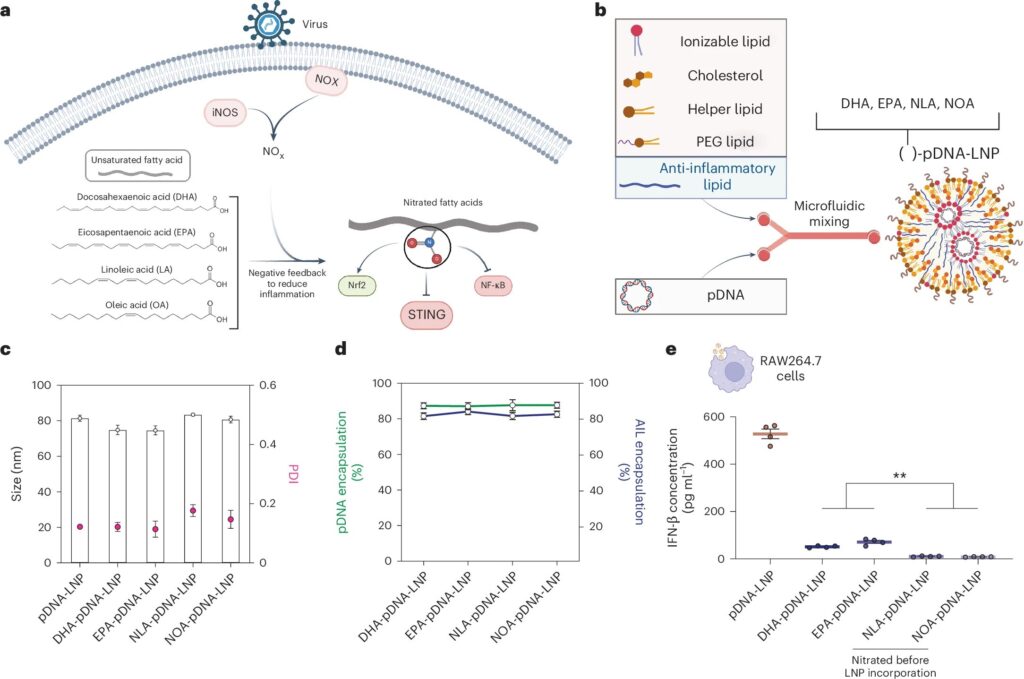A breakthrough in safely delivering therapeutic DNA to cells could transform treatment for millions suffering from common chronic diseases like heart disease, diabetes, and cancer.
A new process that transports DNA into cells using tiny fat-based carriers called lipid nanoparticles (LNPs) developed by researchers at the Perelman School of Medicine at the University of Pennsylvania improved the process of turning on the DNA’s instructions in mice to make proteins inside cells, which is crucial in fighting disease. Signs also point to an improvement in reducing treatment risks, such as immune reactions, as compared to older DNA transfer techniques.
The team’s findings were recently published in Nature Biotechnology.
Nobel Prize-winning work sets the stage
The new approach builds directly on the genetic medicine revolution that began at Penn: the development of safe messenger RNA (mRNA) therapies used in COVID vaccines.
“For 20 years, DNA delivery with LNPs has been a major goal in this field,” said Jake Brenner, MD, Ph.D., an assistant professor of Medicine and Pharmacology. “We’re picking up where mRNA left off to tackle bigger challenges.”
In their Nobel Prize-winning work, Penn’s Katalin Kariko, Ph.D., and Drew Weissman, MD, Ph.D., showed how to modify mRNA to make it safe for delivery in the body. Since then, mRNA-based treatments have entered clinical trials for a variety of vaccines and for delivering CRISPR proteins to edit genes in rare diseases. While mRNA therapies have advanced rapidly, they have limitations for chronic conditions because mRNA breaks down quickly in the body and cannot easily target specific cell types.
DNA delivery offers a compelling solution to these challenges. Unlike mRNA, DNA remains active in cells for months or even years and can be programmed to work only in targeted cells. However, past attempts to use LNPs to deliver DNA failed because they triggered severe immune reactions—when loaded into standard mRNA-LNPs, DNA was lethal to 100% of healthy mice in laboratory tests. For two decades, researchers recognized DNA delivery’s potential but considered it impossible due to these safety barriers.
Solving the safety puzzle
Brenner’s team discovered why previous attempts to deliver DNA using LNPs were dangerous: These particles triggered the body’s internal alarm system—a defensive pathway called STING that normally helps fight infections but causes harmful inflammation when activated inappropriately.
STING detects viruses, bacteria, or damaged DNA. To counter STING-induced inflammation, researchers studied the approach Kariko and Weissman had used 20 years earlier to make mRNA delivery safe: modifying nucleotides (the building blocks of mRNA and DNA). While that approach turned out not to work for STING’s interaction with DNA, it led Brenner’s team to the key finding: Cells produce a natural anti-inflammatory molecule called nitro-oleic acid (NOA).
By adding this protective molecule to the DNA-carrying particles, the researchers completely eliminated the fatal reactions that had previously made this approach impossible. In laboratory tests, all mice receiving the improved DNA delivery system survived.
With this advancement, treated cells produced the intended therapeutic proteins for about six months from a single dose—much longer than the few hours seen with mRNA therapies. Compared to viral methods commonly used for gene therapy, these DNA-LNPs can carry larger genetic instructions, cause fewer immune reactions, target specific cells more precisely, and can be given multiple times without losing effectiveness.
“For 20 years, the use of DNA-LNPs for DNA delivery has been a major goal in the field of genetic medicine,” Brenner said. “This technology holds incredible promise—not just to treat diseases, but to fundamentally change how we address health challenges that affect millions. It builds directly on Penn’s pioneering work in mRNA and represents the next generation of precision medicine.”
Future studies will focus on further refining the technology and testing its effectiveness in different tissues and disease models.


